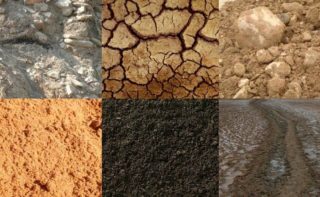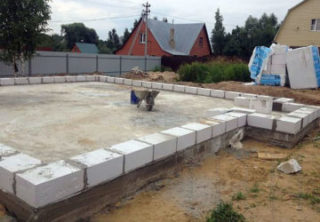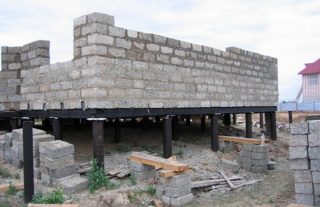Aerated concrete is a popular material in private construction. Residential houses, summer cottages, garages, baths and other ancillary structures are being erected from the blocks. Aerated concrete has a lot of advantages, but it also has disadvantages. In order to fully reveal all the possibilities of the material, one should study its properties and features, and most importantly, choose the right foundation for an aerated concrete house.
Features of aerated concrete blocks

When choosing a foundation for aerated concrete, many factors should be taken into account, the main of which are the characteristics of the material. They differ significantly from the properties of brick, wood, iron and modular panels.
Aerated concrete blocks have the following features:
- The wall is a prefabricated structure with a weak connection between the fragments. The slightest deformation of the base has a negative effect on the masonry.
- The material is lightweight. The foundation for the gas block can be relatively shallow, but with the obligatory deepening below the level of soil freezing.
- Blocks are fragile. They do not tolerate vertical and horizontal loads poorly. To give the structure strength, steel rods are laid between the rows. A reinforced concrete armored belt is made under the floor slab.
- The edges of the blocks are almost perfectly flat. This saves on the bonding solution, which is applied in a layer thickness of 2-3 mm.
When calculating the foundation for a house made of aerated concrete, you need to remember that, in addition to light blocks, heavy door and window lintels made of reinforced concrete will be used during construction. These parts can cause the center of gravity of the building to shift and the pressure on the base to be unevenly distributed.
Taking into account the depth of the foundation when choosing
However, in regions with a cold climate, such an engineering solution can be unjustifiably expensive, since the soil can freeze to a depth of 200-250 cm.In such cases, the technology of a deep foundation with non-removable heat-insulating formwork and the creation of a powerful cushion of rubble and sand is used. This layer will take on the pressure of the earth, which will prevent deformation of the foundation. The thickness of the pillow can be up to 100 cm. In addition, it is advisable to make an insulated blind area and use a facing material with low thermal conductivity for finishing the basement.
The deep and shallow methods have their pros and cons. The choice is made after analyzing all the factors that affect the construction.
Criteria for choosing the type of foundation for a house made of aerated concrete

When choosing the type of foundation for a house made of aerated concrete, a number of circumstances should be taken into account, which cannot be changed or are too expensive and time-consuming.
First you need to dwell on the requirements that apply to the foundations:
- rigidity that excludes linear deformation;
- stability in the ground, regardless of the weather and season;
- even distribution of weight to the soil, which excludes subsidence of one of the sides of the building;
- ability to compensate for soil heaving loads;
- strength, expressed in maintaining the integrity of the structure under pressure.
When drawing up a project, you need to take into account the following factors:
- Configuration, size and height of the building. Each floor creates additional pressure on the base, which requires the addition of centimeters for its height and width. If the house has an attic, this is another 3-4 cm of concrete.
- Weight distribution of structures, furniture and household appliances inside the building. A kitchen block and a bathroom in a two-story cottage can create pressure several times more than the sleeping area on the opposite side. Accordingly, in this part, the foundation of aerated concrete blocks is made more massive.
- The bearing capacity of the soil. This indicator serves to determine the maximum load that can be transferred to the soil without subsidence and pushing. To get the value for your site, you need to take soil samples and find out its composition. Then you need to determine the approximate mass of the fully loaded building and divide by the bearing capacity indicator. The result will indicate the area that the base should have.
- Heaviness of the earth. If in sandy soil it is only 1%, then in wet loam it is 10%. To prevent a light one-story house from being pushed out, measures are taken to fix the base in a non-freezing soil layer or to add additional heating to it.
Having compared all the data, it remains only to choose the type of foundation that will meet all construction conditions.
Which foundation is better
When deciding on the choice of a foundation for a house made of aerated concrete blocks, the advantages and disadvantages of this material should be taken into account. Mistakes or savings can cause the foundation to break down, which can lead to long, difficult and very expensive overhauls. In the worst case, the building is deemed to be damaged and subject to demolition. Therefore, you should approach the design with the utmost responsibility.
Platen

A monolithic reinforced concrete slab is an excellent solution for the construction of houses in areas with unstable soil and high groundwater levels. Depending on the construction conditions, the slab can be smooth or with stiffening ribs, which increase its reliability and stability. Large footprint ensures low ground pressure and even distribution.
The monolithic structure is not an obstacle for home improvement with plumbing and electricity. Communications can be laid in advance, and only then filled with concrete.
Construction sequence:
- Marking.
- Excerpt from the pit, removal of stones and plant roots, compaction of the bottom of the pit.
- Laying geotextile fabric that prevents the growth of grass and bushes, leaching of material from under the slab.
- Dumping a pillow from a mixture of fine gravel and sand. The layer thickness varies between 25-50 cm.
- Insulation placement. To do this, you can use basalt mineral wool or 10 cm thick foam.
- Installation of the reinforcement cage. Fastening the volumetric lattice to the base.
- Laying and fixing household communications - water and sewer pipes.
- Concrete casting and continuous casting.
The finished structure must stand for 28 days. During this period, it should be watered regularly to prevent cracking.
The main advantages of the structure:
- applicability on all types of soil;
- high bearing capacity;
- immunity to deformation;
- the top surface is a finished subfloor;
- long service life.
Disadvantages of slab base:
- there is no way to make a basement;
- lack of access to communications for their inspection, maintenance and replacement;
- high consumption of building materials, and, accordingly, significant costs;
- slight elevation above the ground;
- the complexity of the arrangement on the slopes.
Depending on the type of soil, size and mass of the structure, a monolithic slab with a thickness of 30-50 cm is cast.
Tape

This option for making a foundation for aerated concrete structures is the most popular in private construction for several reasons. On stable soils, shallow structures with a height of 30-50 cm are made. The plinth can be made of concrete or lined with bricks. Another option is to erect a buried tape. This decision is made when building on soft and heaving soils. Large investments in such cases are compensated for by obtaining a full-fledged basement.
Construction sequence:
- Marking, removal of the sod layer, excavation.
- Digging a trench of a given depth and width, taking into account the place for installing the formwork and insulation material.
- Laying waterproofing on the bottom of the pit - roofing material or several layers of dense polyethylene.
- Dumping the shock-absorbing cushion. The thickness of the layer is determined by the depth of the structure and can be 30-60 cm.
- Formwork installation. In order not to transfer expensive lumber to it, it is advisable to rent a factory-made kit.
- Reinforcement laying. The frame should turn out to be monolithic. It must be placed so that metal protrudes from the concrete after it has hardened.
- Wetting the walls of the formwork with water or applying working off on them. Mixing and pouring the solution.
You can continue construction in 28 days.
Advantages of the strip foundation:
- simplicity and relative speed of manufacture;
- quite reasonable cost of the project;
- a sufficient level of strength to withstand even a two-story house;
- the possibility of arranging a functional basement level.
Disadvantages of the design:
- the complexity of the construction of buried belts;
- exposure to heaving soil at a low level of laying;
- difficulties in settling on the slopes.
To relieve pressure on weak soil, a heel is made on the sole of the base - an extension in both directions. In the cold season, this expansion acts as an anchor, preventing the building from being pushed out of the ground.
Columnar

Columnar foundations are used in construction on soils with increased stability and density. The structure is a series of supports on which a grillage, logs or a monolithic floor slab are laid. The material of manufacture is solid clay brick or reinforced concrete blocks.
Installation procedure for the columnar base:
- Marking. Removal of the top layer of soil. An excerpt of foundation pits in the places where the supports are installed.
- Laying waterproofing material on the bottom of the pits. This will prevent the pillars from being washed away by groundwater.
- Filling the holes with fine gravel and sand. Wetting, compacting and leveling the material.
- Installation of supports. Brickwork is done with cement mortar, followed by finishing the walls with a primer and facade plaster. Concrete blocks are installed in grooves or held together with glue.
- Leveling the supports with cement mortar. This will require a laser level.
- Application of a waterproofing layer to the top of the pillars after complete hardening of the cement.
The columnar foundation technology has the following advantages:
- simplicity of the procedure;
- speed of execution;
- small financial costs;
- possibility of mounting on a slope.
Disadvantages of the design:
- the impossibility of arranging the basement;
- restrictions on soil looseness;
- the risk of slipping and skewing;
- insufficient strength of brickwork;
- the impossibility of using for a garage and other buildings with ramps.
Columnar bases can be made on solid ground, with building weight restrictions.This solution is well suited for a light country house, change house, shed or garden gazebo.
Pile

Builders rarely turn to this option for a base for aerated concrete structures when there is no other way out: the construction of buildings on slopes, swampy terrain and on heaving soil. If the building is near a body of water, the piles are used to raise it to a height that provides protection from flood waters.
The following types of piles are used in construction:
- Screw. They are a metal tube with blades on the head. After screwing into the ground, concrete is poured into the product.
- Driving. It is a monolithic reinforced concrete structure with a square section with a pointed end. Driven into the ground with a pneumatic or diesel hammer.
- Buroinjection. They are a hollow pipe that is inserted into a pre-drilled well. After immersion, it is filled with concrete mortar.
The sequence of installation of the pile foundation:
- Drawing up a diagram. The optimal distance is considered to be 200 cm between the supports. This interval will eliminate slab or grillage sagging.
- Marking. Checking the accuracy of measurements along the horizontals and diagonals.
- Installation of piles into the ground. Here one of the methods that apply to each type of pile is applied.
- Aligning the heads. This is done with a grinder when leveling concrete and a gas cutter to shorten steel pipes.
- Concrete grouting if hollow piles were used. A deep vibrator is used to remove air bubbles.
- Grillage making. This structure connects all the piles into one structure, thanks to which the foundation acquires additional stability. The grillage is made of steel beams or reinforced concrete.
Advantages of a pile foundation:
- immersion to a great depth exceeding the freezing point;
- the ability to install on any soil;
- applicability for construction on slopes and at the bottom of reservoirs.
The disadvantages include the high cost of products and the need to attract heavy equipment for their installation.









